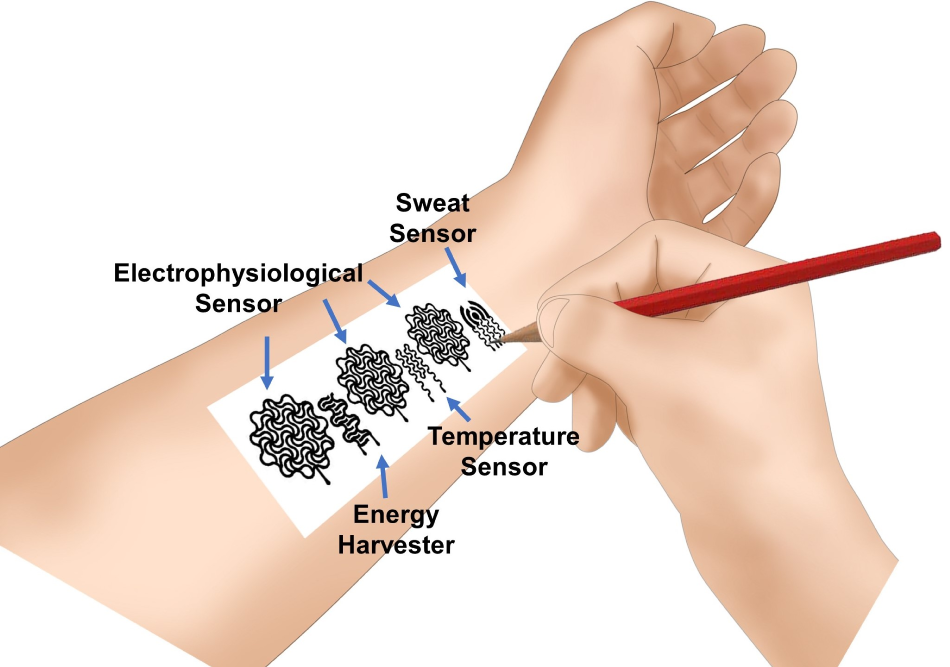Jul 14 2020
In the future, people could start tracking their health conditions just by taking a pencil and drawing a bioelectronic device on their skin.
 One day, people could monitor their own health conditions by simply picking up a pencil and drawing a bioelectronic device on their skin. In a new study, University of Missouri engineers demonstrated that the simple combination of pencils and paper could be used to create devices that might be used to monitor personal health. Image Credit: University of Missouri.
One day, people could monitor their own health conditions by simply picking up a pencil and drawing a bioelectronic device on their skin. In a new study, University of Missouri engineers demonstrated that the simple combination of pencils and paper could be used to create devices that might be used to monitor personal health. Image Credit: University of Missouri.
At the University of Missouri, engineers have carried out research on the feasibility of using a simple combination of paper and pencils to make devices that may be used to track personal health.
The study outcomes were recently reported in the Proceedings of the National Academy of Sciences.
According to Zheng Yan, an assistant professor in the College of Engineering, several existing commercial on-skin biomedical devices generally include two major components—a biomedical tracking component and a flexible material enclosure, like plastic, to offer the component a supportive structure to retain an on-skin connection with a person’s body.
The conventional approach for developing an on-skin biomedical electronic device is usually complex and often expensive to produce. In contrast, our approach is low-cost and very simple. We can make a similar device using widely available pencils and paper.
Zheng Yan, Assistant Professor, College of Engineering, University of Missouri
Pencils—which are made of lead with various levels of wax, clay, and graphite—have generally been used for drawing and writing since their invention.
As part of the study, the team identified that pencils with over 90% graphite have the ability to conduct a high amount of energy made from the friction present between pencil and paper resulting from writing or drawing.
Particularly, they identified that pencils with 93% graphite were the most ideal ones for making a range of on-skin bioelectronic devices drawn on a commercial office copy paper. Yan stated that a biocompatible spray-on adhesive could also be added to the paper to help it stick better to a person’s skin.
According to the team, the findings could find extensive future applications in education, home-based, personalized health care, and remote scientific research, for example, during the course of the COVID-19 pandemic.
Yan noted that the next step would be to further advance and test the applications of the biomedical components, such as biochemical, temperature, and electrophysiological sensors.
For example, if a person has a sleep issue, we could draw a biomedical device that could help monitor that person’s sleep levels. Or in the classroom, a teacher could engage students by incorporating the creation of a wearable device using pencils and paper into a lesson plan. Furthermore, this low-cost, easily customizable approach could allow scientists to conduct research at home, such as during a pandemic.
Zheng Yan, Assistant Professor, College of Engineering, University of Missouri
Yan stated that an extra benefit to their method is that the paper can decompose within a week, in comparison with several commercial devices that involve components that cannot be easily degraded.
The study titled “Pencil-paper on-skin electronics” was recently published in the Proceedings of the National Academy of Sciences. The other authors on the study are Yadong Xu, Ganggang Zhao, Qihui Fei, Zhe Zhang, Zanyu Chen, Yangyang Chen, Yun Ling, Shinghua Ding and Guoliang Huang at MU; Liang Zhu, and Pai-Yen Chen from the University of Illinois-Chicago; Fufei An and Qing Cao from the University of Illinois Urbana-Champaign; and Peijun Guo from Yale University.
The study was financially supported by a University of Missouri start-up fund, and grants from the National Science Foundation, the Air Force Office of Scientific Research, and the National Institutes of Health.
Journal Reference:
Xu, Y., et al. (2020) Pencil–paper on-skin electronics. Proceedings of the National Academy of Sciences. doi.org/10.1073/pnas.2008422117.